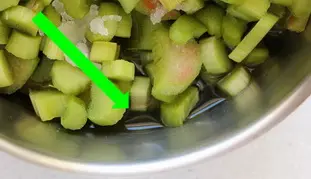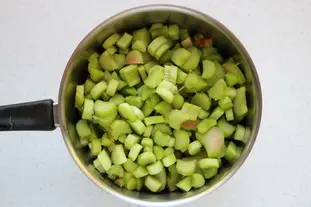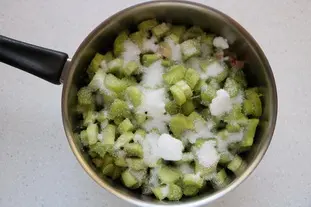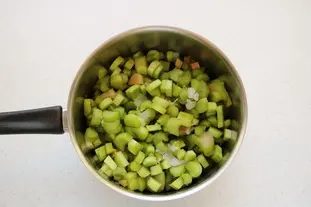This site uses only a few technical cookies necessary for its operation. By continuing to browse, you accept their use.
To find out more...
To find out more...
Fruits and their syrup

As I write these lines, we are finally in the summer, the holidays are approaching, and above all, the fruits are pouring onto the market stalls, if they are ripe, it's time to enjoy them to the full!
11 K 4.7/5 (16 reviews)
Keywords for this post:FruitSummerSyrupSugarCompoteJamLast modified on: July 24th 2019
Fruits and their syrup
You may be about to start making compotes, jams, or a bunch of other recipes based on cooked fruits, in which case you will probably find yourself mixing sugar and fruit at some point before cooking.
In this case, for a compote for example, you will probably add a little water to start the cooking. It's indicated in a lot of recipes, and you may be used to doing it that way, no worries, it's very classic. It works of course, but it's not great this addition of water : it will have to go away afterwards (longer cooking time) and it will make your fruits taste a little bit less spicy.
1) Prepare your fruits, cut them into small pieces, here rhubarb, put in the cooking pot.
2) Add the powdered sugar, mix briefly.
3) Wait, at least 2 hours, overnight if you want, let the sugar work and melt.
After this time, the syrup has started to form, you can see it by tilting the pan a little. It is pure fruit syrup, quite thick and tasty, the ideal texture to start your cooking which will be 100% fruit + sugar.
You can proceed like this with all fruits, for small ones and berries (cherries, blackcurrants, blackberries, raspberries, ...) no need to cut them but you will have to wait a little longer to see the syrup form.
To sum up: When cooking fruit, do not add water, just let the fruit syrup have time to form.
In this case, for a compote for example, you will probably add a little water to start the cooking. It's indicated in a lot of recipes, and you may be used to doing it that way, no worries, it's very classic. It works of course, but it's not great this addition of water : it will have to go away afterwards (longer cooking time) and it will make your fruits taste a little bit less spicy.
Can we do better?
Yes, much better, you have to play on the "syrup" effect between sugar and fruits. When you mix sugar and fruit together, the sugar, which is hygroscopic, pumps the water from the fruit with which it mixes to form a natural syrup. This syrup, as tasty as your fruit, is much better for the start of your future compote or jam.How to make it?
Very simple:1) Prepare your fruits, cut them into small pieces, here rhubarb, put in the cooking pot.

2) Add the powdered sugar, mix briefly.

3) Wait, at least 2 hours, overnight if you want, let the sugar work and melt.

After this time, the syrup has started to form, you can see it by tilting the pan a little. It is pure fruit syrup, quite thick and tasty, the ideal texture to start your cooking which will be 100% fruit + sugar.

You can proceed like this with all fruits, for small ones and berries (cherries, blackcurrants, blackberries, raspberries, ...) no need to cut them but you will have to wait a little longer to see the syrup form.
To sum up: When cooking fruit, do not add water, just let the fruit syrup have time to form.
Lasts posts
Butter vs. grease
We often read in a recipe where a pastry is put into a mould that, just before pouring, the mould should be buttered or greased. But what's the difference between these 2 terms?December 1st 20254915
Getting out of the fridge early
Very often when you're cooking, you need to take food or preparations out of the fridge, to use them in the recipe in progress. There's nothing tricky about this: you just take them out of the fridge and use them, usually immediately, in the recipe. But is this really a good method?November 24th 20258995
Who's making the croissants?
When you look at a bakery from the outside, you naturally think that in the bakery, the bakers make the bread, and in the laboratory, the pastry chefs make the cakes. It's very often like that, with each of these professions having quite different ways of working, but sometimes there's also one...November 23th 2025798
Oven height
When we put a dish or cake in the oven, we naturally tend to put it on the middle shelf, and that's what we usually do. But in some cases, this position and height can be a little tricky, so let's find out why.October 8th 20252,3785
The importance of sieving
In recipes that use a fine powder (flour, powdered sugar, etc.), you'll often see the advice to sift before using it. To sift is to pass the powder in question through a sieve (a very fine strainer) before incorporating it into your recipe. It's often advice, but is it really useful?September 3rd 20257,3053
Other pages you may also like
Steam for baking bread
What does steam have to do with bread-making? This is not only a bakers' secret, it is something you might not think of at all: if you make bread and bake it like a cake, you will end up with bread, but pale and with a thick, hard crust – a long way from the golden-brown crusty loaf you had in...June 16th 2021146 K4.5
Incise some meats before cooking
Have you ever had this rather unpleasant phenomenon: you grill a meat, a pork chop or a veal cutlet for example, and during cooking it becomes completely deformed? It takes a very strange shape, a bit difficult to describe, a sort of cone around the central area of the meat, which also hinders...June 19th 202112 K4.9
No need to boil gelatin
Gelatin is a magical ingredient for making light, creamy, structured desserts, yet it's often misused in the kitchen. A common mistake in some recipes is the idea that it needs to be boiled for it to work properly, but this is a mistake indeed: gelatin melts at a much lower temperature, around...November 21th 20248,0755
Butter doesn't make you fat, unless you eat too much of it.
Whenever I'm discussing cooking and recipes, there is one idea which comes up frequently, like this: "Oh no! But that's got butter in it" (I should add, for the sake of accuracy, that this is something I hear more frequently from women, who are almost all concerned with keeping their figure). ...March 26th 201245 K4.5
The window-pane test in bread-making
The home bread-makers often ask themselves “Have I kneaded my dough long enough?” . A good question, as dough that is insufficiently kneaded will not rise properly or will fall flat when the top is slashed, which is very frustrating. To know when the dough is ready, one can rely on the length...June 16th 202196 K 23.9
Post a comment or question
Follow this page
If you are interested in this page, you can "follow" it, by entering your email address here. You will then receive a notification immediately each time the page is modified or a new comment is added. Please note that you will need to confirm this following.
Note: We'll never share your e-mail address with anyone else.
Alternatively: you can subscribe to the mailing list of cooling-ez.com , you will receive a e-mail for each new recipe published on the site.









